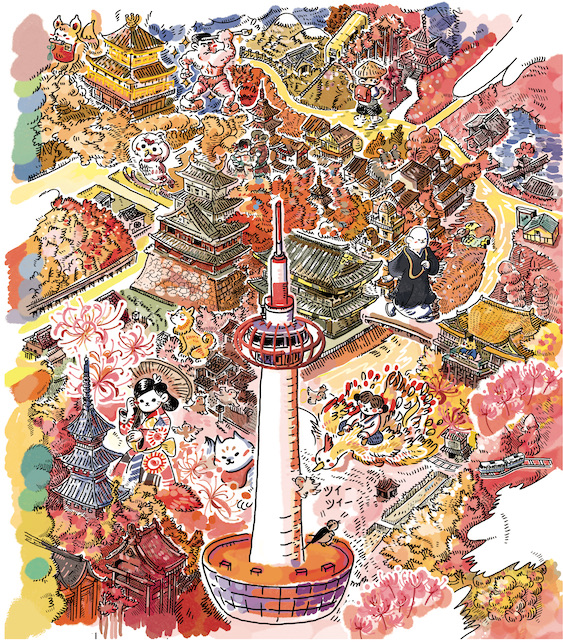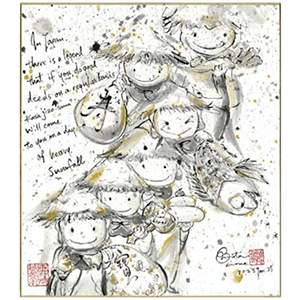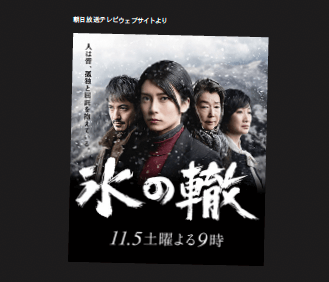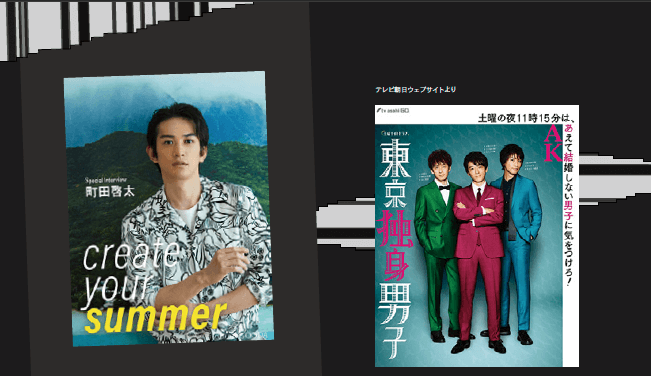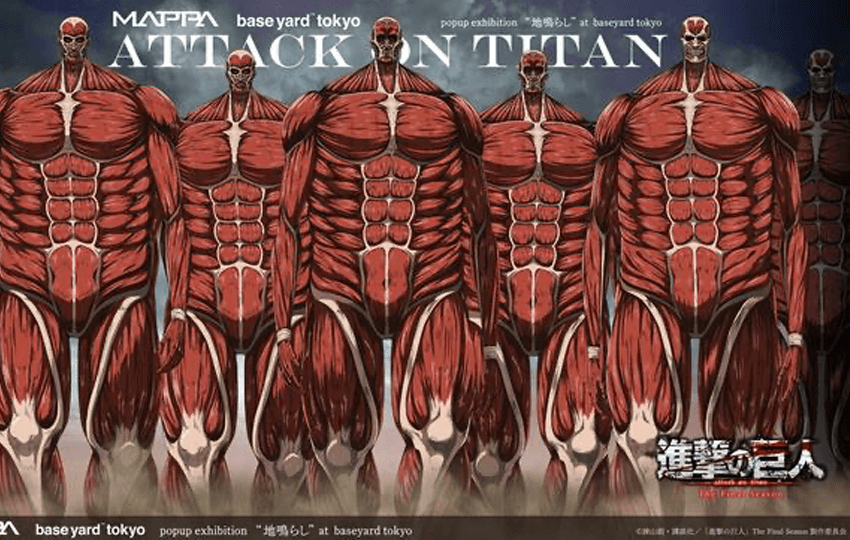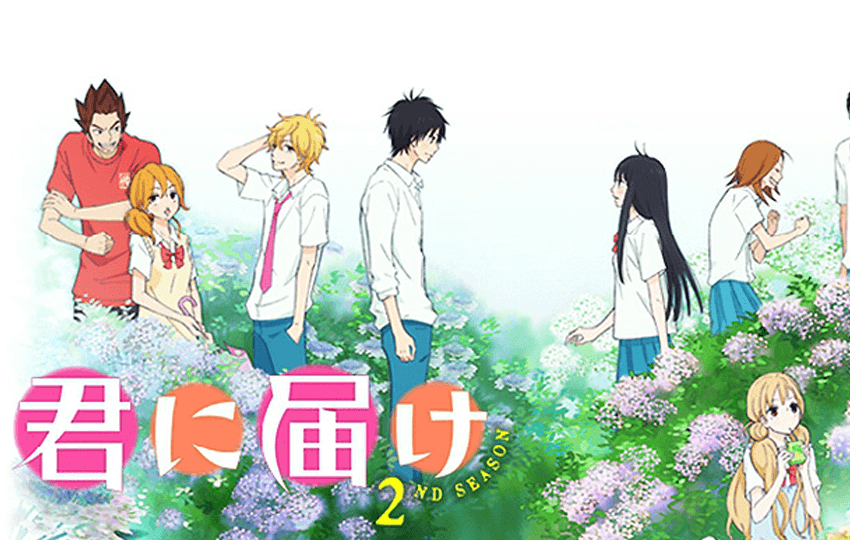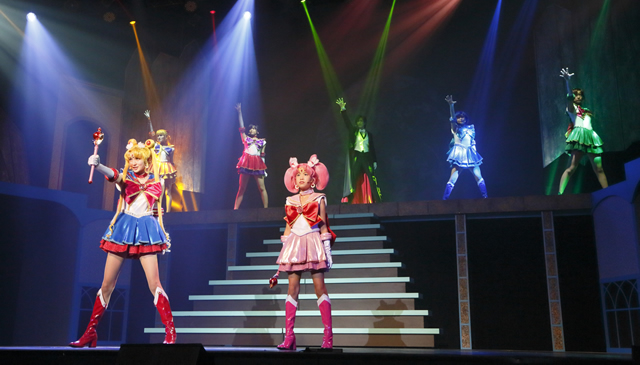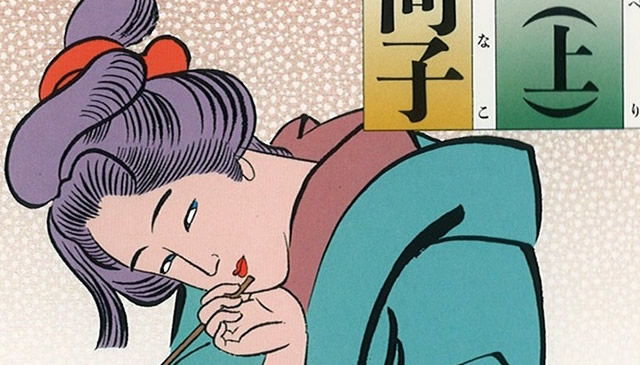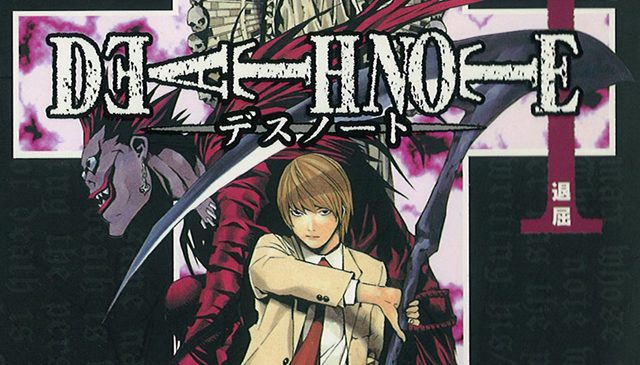-
The Breath of Autumn Illuminates Kyoto — A Tower of Light and the Memory of Red Spider Lilies
- Hiragana Times
- Sep 29, 2025
[Cover Story – September 2025 Issue]
The Breath of Autumn Illuminates Kyoto — A Tower of Light and the Memory of Red Spider Lilies
秋のいぶき、京都に灯る——塔の光と彼岸花の記憶This month’s cover captures a quiet autumnal view of Kyoto, wrapped in warm, seasonal hues.
今月号のカバーは、秋色に染まる京都の街並みを描いた一枚です。
At the center of the scene stands Kyoto Tower, located at the city’s gateway near Kyoto Station. Resembling a tall candle, the tower was inspired by the idea of “a light without fire” in a city filled with wooden architecture.
画面中央にそびえるのは、京都の玄関口・京都駅前に建つ「京都タワー」。まるで一本の大きな蝋燭のようなこの塔は、伝統的な木造建築が多い京都の街に「火を使わない灯り」を灯す、という発想から生まれました。
The tower was completed in 1964—the year of the Tokyo Olympics, a symbolic time when Japan was reemerging on the world stage after World War II. In Kyoto, a city with over a thousand years of history, the tower quietly took its place as a beacon pointing toward the future.
建設されたのは1964年――東京オリンピックの年であり、日本が戦後から立ち上がり、世界に向けて再出発した象徴的な年でもあります。千年の都・京都に立てられたこの塔は、「未来へのともしび」として、人々の希望を静かに照らしてきました。
In the depicted landscape, Kyoto’s iconic temples and shrines—such as Kiyomizu-dera, Kinkaku-ji, Nijō Castle, and Fushimi Inari—are nestled among trees adorned in brilliant autumn leaves, deepening the richness of the scene.
描かれた風景には、紅葉に染まる京都の街並みに、清水寺や金閣寺、二条城、伏見稲荷など、数多くの歴史的建築が点在し、秋の彩りとともに風景に深みを添えています。
Adding a vivid accent of red to the scene are the red spider lilies, or higanbana. Blooming around the autumn equinox, these flowers are also featured in this issue’s Ibuki section, gently evoking memories of ancestors and quiet moments of remembrance.
そこに、鮮やかな赤のアクセントとして咲くのが「彼岸花」。今号の「いぶき」コーナーでも特集しているこの花は、ちょうど秋のお彼岸の頃に咲き、故人を偲び、静かに手を合わせる心を呼び起こします。
In autumnal Kyoto, layers of time overlap, and memory and prayer pass gently through the air.
秋の京都には、時間の層が折り重なり、記憶と祈りがそっと行き交います。
This article is from the September 2025 issue of Hiragana Times.
この記事は、月刊誌『ひらがなタイムズ』2025年9月号より掲載しています。
-
Kasa Jizo (Straw Hat Jizo)
- Hiragana Times
- Feb 08, 2024
Kasa Jizo (Straw Hat Jizo)
笠地蔵
“Kasa Jizo” is one of Japan’s famous traditional stories. It’s a tale of a poor elderly couple living deep in the snowy mountains who receive a favor from Kasa Jizo and repay the kindness.
「笠地蔵」は、日本の有名な昔話の一つです。雪深い山奥に住む貧しい老夫婦がお地蔵さまから恩返しを受ける物語です。
On New Year’s Eve, the elderly couple, who had run out of food, wove kasa (straw hats) in the hope of selling them to buy some rice cakes. The old man went to town to sell the kasa but didn’t sell them at all. When he gives up and starts walking home, it turns into a blizzard. When he reached the outskirts of the village, he noticed six Jizo statues covered in snow. Feeling pity, he cleared the snow off them and placed the unsold kasa on their heads. For the last statue, he even put his kasa on its head.
大晦日、食べるものがなくなった老夫婦は、もちを買う足しにならないかと傘を編み上げました。おじいさんはその笠を売りに町へと出かけますが、笠は全く売れませんでした。あきらめて家に帰ろうと歩き出すと、吹雪になってしまいます。村の外れまで来たところで、頭から雪をかぶった6体のお地蔵さまの姿が目に留まります。おじいさんはかわいそうに思い、雪を払い、売れ残った笠をかぶせてあげました。最後の1体には自分の笠をかぶせてあげました。
The old woman was surprised to see her returning husband covered in snow, but after hearing his story, she said, “Well, you did a good thing,” and rejoiced.
帰ってきたおじいさんの雪だらけの姿に驚いたおばあさんでしたが、地蔵さまの話を聞き「まあ、それは善いことをしましたね」と喜びました。
That night, the two were startled awake by a loud noise and found rice bags, vegetables, and fish piled in front of their house. Then, they saw the figures of six Jizo statues, wearing kasa, disappearing into the distance through the snow. They bowed to the Kasa Jizo in gratitude.
その日の夜、大きな音で目を覚ました2人は、家の前に積まれた米俵や野菜、魚を目にします。そして、遠くに雪の中を去っていく笠をかぶった6体のお地蔵さまの後ろ姿が見えました。おじいさんとおばあさんは、おじぎをして感謝しました。
-
You are the Protagonist
- Hiragana Times
- Jun 27, 2023
You are the Protagonist
あなたが主人公なんです
HONDA Hirohito / 本田博仁
HONDA Hirohito, who made his acting debut in his teens and later transitioned to becoming a stylist. He passionately pursues a unique expression through fashion based on his extraordinary devotion to clothing and a styling philosophy derived from his experience as an actor.
10代で俳優デビューし、その後スタイリストに転身した本田博仁さん。服に対する並々ならぬ情熱と、俳優ならではのスタイリング哲学をベースに、ファッションを通した唯一無二の表現を追求しています。
“The first drama I was in charge of costumes for was ‘BORDER: Metropolitan Police Department, Investigation Department, Homicide Investigation Section 4’ (TV Asahi, 2014). The protagonist is a dedicated detective whose life revolves around his work. He gets shot in an incident, leaving a bullet lodged in his head. This bullet gives him the ability to communicate with the dead and he proceeds to solve a series of murder cases—it’s the story.”
「初めて衣装を担当したドラマは『BORDER 警視庁捜査一課殺人犯捜査第4係』(テレビ朝日、2014年)という作品でした。主人公は仕事一筋の刑事です。彼はある事件で銃撃を受け、頭部に銃弾が残ったままになってしまいます。その銃弾が彼に死者と対話する能力を与え、次々起こる殺人事件を解決していく——というストーリーです」。

“I didn’t know anything about this world, but I developed an image of the main character from various words and created a suit from scratch.The suit was one size up and light gray before I took the bullet, but when I returned to work, I tightened the overall silhouette and lapel (collar) width. The ability to see and interact with the dead. And I wanted to express the tension in his life as he fulfills his mission.”
「右も左もわからない中で、僕は主人公に関するさまざまなワードからイメージを膨らませて、スーツ一式をいちから作りました。スーツは、銃弾を受ける前はワンサイズアップのライトグレーでしたが、職場復帰したときには、全体的なシルエットやラペル(襟)幅などをタイトにしました。死者が見え、対話できる能力。そしてその使命を全うして生きる彼の緊張感を表したかったのです」。
“As the story progresses, the bullet that remains in his brain starts to affect him, and he gradually becomes more unstable. To reflect that, we gradually changed the color of the suit from gray to black. We also made the tie narrower while reducing its brightness. In the final episode, where the tension of the story reaches its peak, I wanted to dress him in a suit that symbolizes his madness, like a mourning attire.”
「話が進むと、脳に残ったままの弾丸が悪さをして、彼は少しずつおかしくなっていきます。それに合わせる形で、スーツの色をグレーから徐々に黒に。ネクタイも色の明るさを落としながら細くしていきました。物語の緊張感がピークに達する最終回で、彼の狂気を象徴する喪服のようなスーツを着せたかったからです」。

Honda’s meticulous work, where he doesn’t cut corners even in the smallest details, was highly praised on the set. He is currently active in a wide range of media, including magazines, television, and advertising. In addition, he also offers a personal styling service called “MITAMENTAL” (a combination of “mitame,” which means appearance, and “mental”).
細部まで手を抜かない本田さんの仕事ぶりは、撮影現場で高く評価されました。彼は現在、雑誌やテレビ、広告など、幅広いメディアで活躍する一方で、「MITAMENTAL」(見た目とメンタル)という、個人向けのパーソナルスタイリングサービスも手がけています。

“I believe that clothing is the outermost expression of a person’s inner self. Even in the casual clothes we choose without much thought, there is inevitably a reflection of our subconscious. For instance, I recently styled a man who had a sleek, all-black ensemble with a sense of luxury, and even his shoes had studs, creating a polished and impeccable appearance.”
「服は、その人の一番外側の内面だと、僕は考えています。普段何気なく選ぶ服にも、その人の無意識が少なからず反映されています。たとえば、最近スタイリングしたある男性は、全身高級感のあるタイトな黒で、靴にも鋲[びょう]がついているような、隙がない見た目をしていました」。
“But he is a simple, pure man. He seemed to be struggling with his relationship with his wife. As we talked, I had an idea, and I took him to UNIQLO. I chose a beige nylon set-up. Inside, I had him wear a pale blue cut and sew.”
「でも、本人は素朴でピュアな人なんです。彼は、妻との関係性に悩んでいるようでした。話をする中で感じるものがあって、僕は彼を連れてユニクロに行きました。選んだのは、ベージュのナイロン素材のセットアップ。中には、淡いブルーのカットソーを着てもらいました」。

“He works as a financial planner and also manages an old traditional house. Because of his pure and gentle personality, I incorporated the softness of beige. Additionally, I brought in the color blue, which conveys an intellectual and sincere image, for the inner layer. I also chose a size one up for the clothes to give him some room to breathe.”
「彼はファイナンシャルプランナーで、古民家経営もしています。ピュアで優しい人柄だから、ベージュの柔らかさを入れました。また、理知的で誠実なイメージを持つブルーをインナーに持ってきました。服のサイズもワンサイズアップして、ゆとりを持たせるようにしました」。
At first, the man was perplexed, but eventually, he expressed the realization that by wearing streamlined garments without unnecessary elements, he may have been trying to exert control over himself.
男性は最初こそ戸惑っていましたが、やがて「無駄を省いたタイトなものを着ることで、自分自身をコントロールしようとしていたのかもしれない」という気づきを口にしたそうです。
“By giving him more room in his clothes, I wanted him to have more room in his heart. And I wanted him to have more room for his wife. Eventually, he reflected on the fact that he had been ignoring his wife’s feelings and spoke of his determination to let go of his conscious control, both over himself and over her.”
「服にゆとりを持たせることで、僕は彼の心に余白を作りたかったんです。そして、奥さんにも余裕を持って接するようになって欲しかった。最終的に彼は、妻の気持ちを無視していたことを反省し、自分に対しても彼女に対しても、意識的にコントロールを手放す決意を口にしました」。
Honda never imposes his own sense of beauty. Whether it’s a fictional character or a real person, he meticulously imagines and understands the lives of those he styles. Taking into account their past and present, he expresses a future through fashion that is suitable for that individual.
本田さんは、決して自身の美意識を押し付けません。架空のキャラクターでも実在の人物でも、スタイリングを行う相手の人生を丹念にイメージし、理解に努め、過去と現在を踏まえてその人にふさわしい未来をファッションで表現します。
“I went from being an actor to a stylist. At the time, I thought I had become a stylist because I wanted to make a living in a profession related to clothing, but looking back now, I realize that was a setback. But because of that experience, I want to tell people to accept and love themselves as they are.”
「僕は俳優からスタイリストになりました。当時は、服に関わる職で生きていきたいという思いからスタイリストに転身したつもりでいましたが、今振り返ると、あれは挫折だったのだと思います。でも、その経験があるからこそ、ありのままの自分を認めて愛することを伝えたい」。
“If you see yourself as the main character, the way you perceive things, the way you relate to others, and even the color of your life will change. In this day and age, there are many people who live their lives being swept away by their surroundings. I believe that the way you are in your own mind is everything.”
「自分を主人公として捉えれば、物事の受け取り方も人との関わり方も、さらには人生の彩りすら変わってきます。今の時代、周りに押し流されて生きている人は少なくありません。自分の心の在り方が全てだと思います」。
“I face my heart through my clothes. I believe that by getting to know yourself in this way, you can find your own personal comfort. Ultimately, I aim to create a style in which the person can be comfortable and be themselves, even in simple fashions like a white T-shirt and jeans. That is ultimately my proposal and what I want to do.”
「服を通して心と向き合う。そうして自分を知っていくことで、自分だけの心地良さを見つけられるのではないかと思います。究極的には、白いTシャツにジーンズのようなシンプルなファッションでも、その人が自分らしく、心地よくいられるスタイルを目指す。それが最終的には僕の提案であり、やりたい事です」。

Text: SAWAGUCHI Shota
文:澤口翔太
How To Purchase Magazines
Get your copy today and embrace the colorful world of Hirohito Honda’s creations.
Get your copy of the magazine now, available on Amazon, major bookstores, or through this link. Let the journey begin!Click here to get your copy是非、カラフルな誌面で、本田博人のファッションセンスを吸収しよう!本誌のお求めは、Amazon、大手書店もしくは、こちらのリンクからどうぞ。
-
[:ja][2015年8月号掲載記事]
進撃の巨人
謎の巨人に襲われ、絶滅の危機に立たされた人間達が、巨人との終わりのない戦いに挑む物語。2009年に別冊少年マガジンで連載が開始され、現在も続いています。この作品でデビューした諫山創は発表と同時に注目され、2011年には講談社漫画賞少年部門を受賞しました。単行本の累計発行部数は4,400万部を超えています。
時は845年、繁栄を築いた人間は突然現れた巨人に襲われます。人間を食べる巨人から守るため、巨大な三重の城壁を造り、その内側での生活を強いられます。調査兵団が時々視察のために城壁を出ますが、巨人から被害を受けるだけで勝てる見込みはありません。10歳の少年エレンは壁の外の世界へ憧れを抱き、調査兵団に入りたいと望みます。
城壁内は100年間平和が続いていましたが、ある日巨人達が城壁を壊して侵入してきます。そしてエレンの母親が巨人に食べられてしまいます。助けることができなかった無念からエレンは復讐を決意。いつもエレンを見守る幼なじみの少女ミカサと共に訓練団に入団します。
それから数年後、エレンとミカサは優秀な成績で訓練団を卒業します。二人は志願して、巨人のいる壁の外を調査する調査兵団に入ります。エレンは固定砲の整備を行っているときに巨人に襲われます。足に傷を負いながらもエレンは仲間を助け、その身代りに巨人に食べられてしまいます。
エレンの死を聞いたミカサはショックを受けますが、戦う気持ちを奮い立たせて仲間を先導します。そんななか、巨人を攻撃する巨人が現れます。その巨人はミカサのピンチを救い、何体もの他の巨人を倒して力尽きます。その倒れた巨人の体からは、死んだはずのエレンが現れます。
エレンがなぜ巨人になるのかなど謎が解き明かされながら、物語は進んでいきます。単にヒーローが活躍するのではなく、悩み、苦しむ主人公の姿は読者の支持を集めました。また様々な伏線が張られているので、読み返すと新たな発見があるのも特徴です。韓国やアメリカなど海外でも発行され、高い人気が続いてい
ます。
文:瓦谷登貴子[:en][From August Issue 2015]Attack on Titan
This is a story in which the human race is brought to the brink of extinction by a mysterious race of giants called titans that is constantly waging war against them. The series began in 2009 in a supplement of Shonen Magazine and continues to this day. People took notice when ISAYAMA Hajime made his debut with the publication of this work and in 2011 he won the boy’s manga prize of the Kodansha Manga Award. More than 44 million copies have been sold in book form.
The human race is flourishing, but in the year 845 giants appear out of the blue and attack. Humans have no choice but to live within three huge walls that are built to protect them from these man-eating titans. The Survey Corps occasionally ventures outside the walls to scout the lay of the land, but they suffer heavy casualties and stand no chance of winning. Ten year old Eren dreams of the world outside the walls and hopes to join this Survey Corps.
Peace reigns for 100 years inside the walls, but one day the titans break through the walls. One of them eats Eren’s mother. Distraught that he is unable to save her, Eren makes up his mind to take his revenge. He enrolls in the Training Corps along with Mikasa, a childhood friend who has always kept an eye on him.
A few years later Eren and Mikasa graduate from the Training Corps with excellent grades. The two volunteer to join the Survey Corps which investigates the area outside the walls where the titans live. Eren is attacked by titans while trying to fix a canon. Though wounded in the leg, he saves his comrade and is eaten instead by the titan.
Misaka is shocked by the news of Eren’s death, but she summons enough courage to lead her comrades in an attack. Meanwhile, a titan appears that attacks other titans. When Misaka is cornered, this titan comes to her rescue and collapses after defeating many other giants. Eren – who had been presumed dead – emerges from the body of this fallen titan.
As the story unfolds mysteries, such as why Eren transforms into a titan, are revealed. Readers root for the main protagonist who is not only heroic, but is also plagued by doubts and angst. Another key feature of this manga is that you can find something fresh in its various subplots when you reread it. The manga continues to be popular and has also been published overseas, in countries such as South Korea and the United States.
Text: KAWARATANI Tokiko[:] -
[:ja]
[2015年7月号掲載記事]
君に届け
北海道を舞台に、見た目が暗い主人公が、クラスメイトとの交流で成長していく姿を描いた物語。2005年に別冊マーガレットで連載が始まり、現在も続いています。単行本は23巻まで発行されており、累計発行部数は2,600万部を超えています。
高校1年の黒沼爽子は、入学してから数カ月経つというのに友達がいません。本名ではなくホラー映画の主人公「貞子」と呼ばれ、周囲から避けられています。生徒だけでなく教師までもが、爽子は霊感が強く目が合ったら呪われるといううわさを信じています。
ただ一人、風早翔太だけは違いました。爽子に対しても他のクラスメイトと同じように接します。風早は入学式の朝、学校への道を教えてくれた爽子のやさしさに気づいており、みんながいやがる学級委員や雑用係を率先して行う彼女の姿に感心していました。
あるとき、クラスで肝試しが行われることになりました。吉田千鶴と矢野あやねは、爽子がお化け役をやれば盛り上がるのにと話します。それを聞いた爽子はみんなの役に立ちたいと志願します。千鶴とあやねは爽子の純粋でやさしい内面に気づきます。風早は、二人と交流する爽子を嬉しそうに見守り、また、クラスのみんなと仲良くなりたいと願う彼女を応援します。
席替えをきっかけに爽子の環境は変わります。爽子の近くの席になることをみんながいやがりますが、風早はくじ引きをパスして爽子の隣に座り、千鶴とあやねも爽子の近くの席に座ります。成績優秀な爽子が彼らに勉強を教えたことから、他の生徒の爽子を見る目が変わっていきます。
悪いうわさや誤解によって風早を避けてしまったり千鶴やあやねと気まずくなったりすることもあります。それを乗り越えることで彼らとの友情は深まり、様々な学校行事を通じてクラスにもとけこんでいきます。そして、爽子は風早を好きだという気持ちに気づくのです。
かつての少女まんがでは、平凡な主人公が魅力的な男性に見初められて両思いになり、ハッピーエンドというのが主流でした。この物語は、主人公が周囲に支えられながら自分の力で友情と恋を育んでいきます。
文:瓦谷登貴子
[:en][From July Issue 2015]
Kimi ni Todoke: From Me to You
Set in Hokkaido, this story depicts the journey into adulthood of its intimidating-looking heroine through her interaction with classmates. First published in Bessatsu Margaret magazine in 2005, it is still running to this day. Twenty three volumes in the book version have been published, with a total of over 26 million copies printed.
Although a few months have passed since she entered high school, first year KURONUMA Sawako hasn’t made any friends. Her classmates avoid her and, rather than addressing her by her real name, call her “Sadako” – the name of the main character in a horror movie. And it’s not just the students; even the teachers believe the rumor that Sawako possesses supernatural powers and can curse people simply by making eye contact.
But there is one exception, KAZEHAYA Shota. He treats Sawako just like his other classmates. He recognized Sawako’s kindness when she showed him the way to school on the morning of their school entrance ceremony and was impressed by how she took the initiative by taking on the unpopular role of class representative and by being responsible for class chores.
One day, a test of courage is planned. While chatting, YOSHIDA Chizuru and YANO Ayane say that the event would be more interesting if Sawako played the role of the ghost. On overhearing this, Sawako volunteers. Chizuru and Ayane recognize that Sawako has a pure and kind heart. Kazehaya is pleased to see Sawako getting along with these two and supports her attempt to make friends with the rest of her classmates.
Sawako’s circumstances change when the students switch seats. While most of the class is unwilling to sit next to Sawako, Kazehaya refuses to draw lots for seating and sits next to Sawako; Chizuru and Ayane do the same. The other students begin to view the high-achieving Sawako differently when they see her helping her friends with their studies.
At times spiteful rumors and misunderstandings make Sawako push Kazehaya away or make things awkward between her and Chizuru and Ayane. Overcoming this, her friendship with the three deepens and during various school events, she gradually blends into the class. Then, she realizes she has romantic feelings for Kazehaya.
Traditionally in girls’ manga, an ordinary girl meets an attractive boy and he falls in love with her for a happy ending. In this story, however, supported by those around her, the heroine finds love and friendship through her own strength of character.
Text: KAWARATANI Tokiko[:] -
Bringing Japanese Pop Culture to the World
- Hiragana Times
- May 10, 2016
[:ja][2015年6月号掲載記事]
TOKYO IDOL PROJECT
2015年3月、日本のアイドル文化を国内外へ発信する「TOKYO IDOL PROJECT」がスタートしました。フジテレビ、コンテンツ事業局アカウントプロデューサー、濵田俊也さんは記者会見で話しました。「アイドルの魅力をアイドルファンの方だけでなく一般の方にもお届けし、2020年の東京オリンピックに向けて日本と東京の盛り上がりをお手伝いしたいです」。
記者会見には、でんぱ組.inc、アイドリング!!!、ベイビーレイズJAPAN、Negicco、HKT48の5組のアイドルも出演して歌を披露しました。そして、「日本各地にすばらしいアイドルがたくさんいるということを伝えたい」「アイドルを通して日本のよさを知ってもらいたい」と抱負を語りました。
日本の芸能界では多くのアイドルが活躍しています。たいていは2人組から数十人の女の子または男の子のグループです。美しさや歌、ダンスのうまさより、かわいらしさや親しみやすさ、がんばっている様子が人気となる傾向があります。最近は、特定の商品や地域のPRを目的とするご当地アイドルも各地にいて、アイドルの活動はますます多彩になってきています。
日本のアイドルファンの特徴は、パフォーマンスを見るだけでなく、好きなアイドルがより有名になることやグループ内で昇格することを熱心に応援することです。そのため、ファンを対象とした握手会などのイベントには多くの人が集まり、テレビで生放送されるほど規模が大きくなることもあります。アイドルやそのファンが起こすムーブメントは日本のポップカルチャーの一つとなり、外国、特にアジアでも人気が高まっています。
TOKYO IDOL PROJECTは、このようなアイドル文化をより盛り上げるために始まりました。アイドルの活動や魅力をテレビ、ウェブ、雑誌、新聞、ラジオなどさまざまなメディアで伝えます。取り上げられるのは主に女性アイドルで、主要コンテンツは現在のところ4点です。
その一つ「TOKYO IDOL FESTIVAL」は2010年から行われている大規模なアイドルイベントです。2014年は138組のアイドルが出演し、4万人以上の観客が集まりました。今年は8月1日と2日に東京のお台場で開催されます。
TOKYO IDOL PROJECT LIVEはTOKYO IDOL PROJECTの基幹コンテンツで、毎月日本の各地で行われる予定です。TOKYO IDOL WEBは記事の掲載やライブの動画配信などを行う世界最大級のアイドルポータルサイトです。コラムニストによるアイドル論を載せるなどアイドルの再定義を目的としているのが特徴です。TOKYO IDOL PROJECT TVではTOKYO IDOL PROJECT LIVEの公演の様子やアイドルの最新情報などを伝えます。
TOKYO IDOL PROJECT [:en][From June Issue 2015]TOKYO IDOL PROJECT
In March 2015, the “TOKYO IDOL PROJECT” to promote Japan’s idol (pop star) culture in and outside Japan, was launched. HAMADA Shunya – who works as an account producer for the Content Division of Fuji TV – stated at a press conference for the event, “By communicating the appeal of idols, not just to their existing fans, but also to the general public, I hope to get the nation and Tokyo fired up about the Tokyo Olympics in 2020.”
Five groups of idols – Denpagumi. Inc., Idoling!!!, Babyraids JAPAN, Negicco and HKT48 – made an appearance at the same press conference to perform songs. They then talked about their ambition “to let people know Japan has wonderful idols in every region” and “to help the world discover positive aspects of Japan through us idols.”
A large number of idols are active in Japan’s entertainment business. Most are all female or all male groups with two to a few dozen members. As a rule, their popularity is based not on their beauty, nor on their singing and dancing abilities, but on their cuteness, friendliness, and dedication. Nowadays, idols have branched out into different fields; for instance there are also so-called local idols whose role is to advertise a particular product or region.
Typically, Japanese fans not only watch their favorite idol’s performance but also root enthusiastically for them to become more famous, or for their status to rise within the group. That’s why many people attend fan events such as meet-and-greet sessions. Some of these events are large enough to be broadcast live on TV. Idols and the movements spawned by their fans have become part of Japan’s pop culture and their popularity is on the rise overseas, more particularly in Asia.
The TOKYO IDOL PROJECT was launched to further promote this idol culture. It broadcasts details of the idols’ activities and charms through various media, including television, the web, magazines, newspapers, and radio. It’s mostly female idols that are covered and at the time of writing, there are four main points through which the campaign is run.
The TOKYO IDOL FESTIVAL is one of these projects and is a large scale event that has been held since 2010. In 2014, 138 groups of idols performed and more than 40,000 spectators attended. This year it’ll be held on August 1 and 2 at Odaiba, Tokyo.
TOKYO IDOL PROJECT LIVE is the main vehicle for TOKYO IDOL PROJECT and will be held every month in different parts of Japan. TOKYO IDOL WEB is one of the world’s largest idol websites offering, among other things, articles, and videos of lives shows. The website is unusual in that it aims to redefine idols by publishing essays about idols by its columnists. TOKYO IDOL PROJECT TV broadcasts clips from concerts and provides up-to-date information about idols.
TOKYO IDOL PROJECT [:] -
Story of a Boy who Wants to Toughen Up
- Hiragana Times
- May 10, 2016
[From June Issue 2015]
Is it Wrong toTry to Pick up Girls in a Dungeon?, Cover of first issue
Is it Wrong to Try to Pick up Girls in a Dungeon?
In Japan, “light novels” are a literary genre. Written for young people in a light and easy style, many use cartoonish images on their covers and in their illustrations. This manga adaptation of a novel won the first prize in the new work category at the “These light novels are great! 2014” Awards. It’s been serialized in Young GanGan magazine since 2013 and four volumes of the series have been published so far.
Set in a dungeon similar to those found in video games, it’s the story of a boy who wants to toughen up. The dungeon is a maze divided into several levels in which all kinds of ferocious monsters appear. Those who venture into the dungeon obtain “fairy stones” by killing monsters.
“Gods,” “elves,” and “prums” (a tribe of dwarfs), live alongside “humans” in Ororio, a megalopolis built above the dungeon. The main character Bell CRANEL is a typical human in that he is pursuing wealth and women in the dungeon. He is not an accomplished adventurer, but he dreams of impressing cute girls by killing monsters in front of them.
One day, seeking an encounter with a woman, Bell sets off on an adventure and ascends to the level above. There, he’s attacked by the Minotaur, but is saved by a girl called Ais WALLENSTEIN. Bell falls in love with the beautiful Ais, who has long blond hair and golden colored pupils, and hopes to become as tough as she is.
All adventurers are members of “Familia,” each of which is centered round a deity. Each deity grants its adventurers powers to fight monsters with and is sustained by the fairy stones that the adventurers bring back. It’s a mutually beneficial relationship and Bell believes that by joining a Familia one becomes part of the deity’s family.
Bell’s Familia is led by the goddess Hestia, and he is the only member. They have difficulties making ends meet and Hestia works part time, even though she’s a goddess. Moreover, she gets heavily in debt after asking a friend to make a weapon that only Bell can use. As a result, she has two part time jobs. She cares so much for Bell that she even forgets her divine pride and hopes to one day become his lover.
As his love deepens for Ais, Bell’s skill as an adventurer improves. Because he’s genuine and kind, it’s not only Hestia who gives him a helping hand, but also other women he encounters. The goddess Freya takes a fancy to him and attempts to lure him away from Hestia. As he matures, even Ais begins to care about Bell.
The attraction of this story is not only in seeing how this boy becomes a man by battling monsters, but also how each awkward romance develops.[2015年6月号掲載記事]ダンジョンに出会いを求めるのは間違っているだろうか
日本には「ライトノベル」と分類される小説があります。若い人向けに軽妙な文体で書かれており、表紙や挿絵にはまんがのような絵が使われることが多いです。これは「このライトノベルがすごい!2014」新作部門で1位になった同名のまんがです。2013年からヤングガンガンにて連載されており、コミックスは4巻まで発売されています。
ゲームの世界ではよく出てくる「ダンジョン」を舞台に、強くなりたいと願う少年の物語。ダンジョンとはいくつもの階層に分かれている迷宮で、さまざまな種類の凶暴なモンスターが現れます。ダンジョンを冒険する者はモンスターを退治することで「魔石」を手に入れます。
ダンジョンの上に築き上げられた大都市、オラリオには「ヒューマン(人間)」の他、「神」「エルフ」「パルゥム(小人族)」などが暮らしています。主人公、ベル・クラネルは、ダンジョンで大金や美女との出会いを求める、どこにもいるヒューマン。冒険者としてのレベルは低くても、かわいい女の子の前でかっこよくモンスターを倒すことを夢見ています。
ある日、ベルは女の子との出会いを求めて冒険したくなり、自分のレベル以上の階層へ行ってしまいます。そこでミノタウロスに襲われますが、アイズ・ヴァレンシュタインという少女に救われます。長い金髪と金色の瞳を持つ美しいアイズを好きになったベルは、彼女のように強くなりたいと願います。
冒険者は皆、神を中心とする「ファミリア」に所属しています。神はモンスターと戦うための能力を冒険者に授け、また、冒険者がとってくる魔石によって養ってもらいます。利用し利用される関係ですが、ファミリアに加わることは神様の家族になることだとベルは考えています。
ベルの所属するファミリアは、女神ヘスティアと二人だけです。生活は苦しく、ヘスティアは神であるにもかかわらずアルバイトをしています。しかも、友達に頼み込んでベル専用の武器を作ってもらったため、巨額のローンを背負います。そのためアルバイトはかけもちです。ベルのためなら神としてのプライドも捨てられるほどで、いつかベルと両思いになりたいと願っています。
ベルがアイズを思う気持ちに比例して、ベルのレベルはどんどんアップします。純粋でやさしいベルを、ヘスティアだけでなくまわりの女性たちも応援するようになります。女神フレイヤはベルを気に入り、ヘスティアから奪おうとします。アイズもまた、急成長するベルのことを意識するようになります。
モンスターとの戦いを通して少年が成長するところだけでなく、それぞれの不器用な恋の行方も見どころです。
-
2.5-Dimensional Musicals
In March, 2015, AiiA 2.5 Theater Tokyo opened in Shibuya, Tokyo. It is the world’s first theater dedicated to “2.5-Dimensional Musicals,” that is theatrical productions based on manga, anime, and video game titles that faithfully recreate the original’s atmosphere and characters.
Recently 2.5-Dimensional theatrical productions are increasingly being staged in Japan and audience numbers are growing too. In 2013, about 1,600,000 people attended a 2.5-Dimensional performance. In 2014, the Japan 2.5-Dimensional Musical Association Secretariat was established and began its activities, performing tasks such as compiling and sending out information on all performances both within and outside Japan. The association also opened the dedicated theatre.
There is an English page on the association’s official website, and it’s possible to purchase tickets from outside Japan. In addition, subtitles are available through a wearable terminal at the theatre. Audiences can choose from a maximum of four optional languages, though the subtitle languages available do change depending on the performance.
“When the popular musical ‘Pretty Guardian Sailor Moon: The Musical,’ was staged, 20 to 30 percent of the audience was from outside Japan. When this dedicated theatre was opened, in the hopes of getting more foreigners to see our shows, we installed a subtitle system,” says TODA Naomi, head of PR. “Since it is wearable, it’s possible to read the subtitles without taking your eyes off the actors.”
In Japan, in 1974, works like “The Rose of Versailles” were adapted into musicals, since then there have been theatrical productions of original manga and anime. “There is a long history of manga and anime being adapted into theatrical productions. But the genre only started to gain wider recognition when the ‘MUSICAL THE PRINCE OF TENNIS’ was staged in 2003,” says Toda.
This musical was well-received by fans of the manga, for its skillful recreation of the original work’s atmosphere. It also went down well with theatrical fans for the production effect of showing the movement of a ball with a spotlight. “It was a good example of how the world of manga could be successfully adapted for the stage,” says Toda. As the appreciation of both manga and anime rose at home and abroad, the number of adaptations that stayed faithful to the original increased. This resulted in the birth of the so-called “2.5-Dimensional” genre.
“Rather than mimicking characters, actors play these parts by trying not to undermine the image of the characters in the original work. The director also does his best to recreate the world shown in the original work on the stage. And that’s why the audience’s imaginations are stimulated to fill in the blanks, thus enabling them to visualize the original work on the stage,” says Toda. The 2.5-Dimensional Musical, “Live Spectacle NARUTO” is scheduled to be staged in Macao, Malaysia, and Singapore. Plans to promote this genre to the overseas market are advancing.
The Japan 2.5-Dimensional Musicals Association Secretariat2015年3月、東京・渋谷にアイア2.5シアタートーキョーがオープンしました。ここは、まんがやアニメ、ゲームを原作としていて、原作の雰囲気やキャラクターを忠実に再現する「2.5次元ミュージカル」を専門に上演する世界初の劇場です。
2.5次元の舞台芸術は近年日本で上演が増えていて、観客の数も増加しています。2013年には約160万人以上の人が観劇しました。2014年には日本2.5次元ミュージカル協会が設立され、各公演情報を一括して国内外に発信するなどの活動を始めました。専用劇場のオープンもこの協会によるものです。
協会の公式サイトには英語のページもあり、海外からもチケットを買うことができます。また、劇場にはウェアラブル端末による字幕システムが用意されています。公演によって字幕言語は変わりますが最大4ヵ国語が設定でき、観客はその中から選ぶことができます。
「人気のミュージカル『美少女戦士セーラームーン』を公演した際、すでに2~3割のお客様が外国の方でした。専用劇場のオープンにより、もっと多くの外国の方に舞台を見ていただきたいと思い、字幕システムの導入を進めました」と協会の広報を担当する遠田尚美さんは言います。「ウェアラブルなので役者から目を離さずに字幕をお読みいただけます」。
日本では1974年に「ベルサイユのばら」がミュージカル化されるなど、まんがやアニメを原作とした舞台芸術は以前からありました。「まんがやアニメを原作とした舞台芸術の歴史は意外と古いのです。でも、このジャンルの舞台芸術が認知され始めたのは2003年に上演されたミュージカル『テニスの王子様』といえます」と遠田さん。
この作品は原作の雰囲気を巧みに表現してまんがファンに歓迎されました。球の動きをスポットライトで表現するなどの演出は演劇ファンにも好評でした。「まんがの世界を舞台上に表現するための『変換』がうまくいった良い例でした」と遠田さん。国内外においてまんがやアニメに対する評価が上がったこともあり、原作らしさを追求した作品が増えました。そして「2.5次元」という呼び方が生まれました。
「役者は原作のキャラクターをまねするというよりも、そのキャラクターの持つイメージを損なうことなく演じ、演出家も原作の世界観を舞台上に再現します。だからこそ観客は想像力を刺激され、欠けている部分を空想で補って原作そのもののシーンを舞台上に見るのです」と遠田さん。2.5次元ミュージカルは、「ライブ・スペクタクル NARUTO -ナルト-」がマカオ、マレーシア、シンガポールでも上演されるなど、今後は積極的な海外進出も予定されています。
一般社団法人日本2.5次元ミュージカル協会
文:砂崎良 -
[From May Issue 2015]
Sarusuberi (Crape Myrtle)
This story is about “ukiyoe” (wood block print) artist KATSUSHIKA Hokusai, and his daughter Oei, who lived in Edo – the former name of Tokyo. Drawing on her knowledge as a scholar of Edo manners and customs, writer SUGIURA Hinako carefully depicts the culture and lifestyle of the common people of those times. The title, “Sarusuberi,” is taken from a flower that blooms for about 100 days from early summer to autumn. According to the writer, the vitality of the plant whose recurring blossoms are heavy enough to bend its branches, chimes with her image of Hokusai. The story was serialized in Manga Sunday Magazine from 1983 to 1987.
On a winter morning in 1814 towards the end of the year, IKEDA Zenjiro, one of Hokusai’s pupils, rushes into the tenement house where his master Hokusai and his master’s daughter, Oei live. When Oei says she does not want any trouble, Zenjiro hands her a picture, saying he has just seen a freshly severed woman’s head. He has drawn a picture of a head that has been displayed in front of the gate of a samurai residence. Hokusai says he wants to see the sight for himself and, accompanied by Zenjiro, sets off to see it for his own amusement.
But the facts about the case of the severed head become clear when Zenjiro saves the life of a man who tries to take his own life by throwing himself into the river. The man was in service to a samurai and the head belonged to this samurai’s daughter. The daughter had fallen in love with a man from a different class and had been forced to break off the relationship. Subsequently this man was executed. Following him in death, the daughter took her own life. The man who had tried to throw himself into the river, had told his master about the couple’s relationship. After placing the woman’s head at the gate, he tried to kill himself, too.
Unsurprised by this, Hokusai simply convinces the man to enter the Buddhist priesthood so he can free himself from his suffering. Hokusai never offers consolation that is considerate of people’s feelings, nor does he give advice to lighten the heart. The way Hokusai behaves reflects the unsentimental mind-set of Edo’s citizens.
Hokusai is a sharp-tongued and short-tempered man who, despite being married, has affairs with his female pupils. When he is invited to show off his painting skills to the shogun, he fails to impress. A lively portrait is painted of an eccentric and fallible human being.
The appeal of this work is, in addition to the character of Hokusai, its affectionate depiction of people living in Edo. Mingled with the stories dealing with everyday life are stories in which dead people and ghosts appear. During this period of undeveloped medical treatment, earthquakes and famines occurred. Death was close at hand and this world and the afterlife existed side by side. The wall between reality and illusion was thin, enabling humans and fantastical beings to easily come and go between the two worlds.
At the story draws to a close, Hokusai divines that his infant daughter has died when a strong wind blows on his tenement house. Here, more than sorrow, the fragility of life is emphasized. At the same time, Hokusai’s deep fear of death is portrayed. This is not the only part of this work in which Hokusai shows his weak side. The work shows Hokusai not only as a great artist but also as KAWAMURA Tetsuzo, an ordinary man, as well as depicting the town of Edo where he lived.
Text: HATTA Emiko[2015年5月号掲載記事]百日紅
東京が江戸と呼ばれていた頃、浮世絵師として活躍した葛飾北斎と、娘お栄の暮らしを描いた物語です。江戸風俗研究家でもあった作者、杉浦日向子の知識を活かして、当時の文化や庶民の生活がていねいに描かれています。タイトルの百日紅は、初夏から秋まで百日間花が咲く植物のことです。作者は、花の重みで枝が曲がるほど咲き、花を散らせてはまた咲かせ続ける百日紅の生命力が、北斎に重なったと語っています。漫画サンデーにて1983年から1987年まで連載されました。
時は1814 年、年の瀬が近い冬の朝、北斎とお栄が住む長屋に弟子の一人である池田善次郎が飛び込んできます。面倒はお断りだと文句を言うお栄に、善次郎は「女の生首を見た」と絵を手渡します。武家屋敷の門前に置かれた生首を描き写してきたのです。北斎は自分も見たかったと悔しがり、気晴らしに善次郎を連れて出かけます。
途中で川へ身を投げる男を目撃し、善次郎がその男を助けたことから、生首事件の真相が明らかになります。首の主は男が仕えていた武士の家の娘でした。娘は身分違いの恋をして仲を引きさかれたうえに、愛した人を死罪にされてしまいました。そして後を追って命を絶ったのです。二人の仲を主人に告げ口したのが、身投げした男でした。彼は娘の首を門前に供え、自分もまた死のうとしていたのです。
北斎は驚きもせず、あっさりと男を出家させて苦しみを断ち切ってやります。決して相手の気持ちに寄りそってなぐさめたり、心を軽くする言葉をかけるような思いやりを表には出しません。こうした北斎の振る舞いは、湿っぽさを嫌がる江戸っ子ならではの気質です。
口が悪くて気が短く、妻がいながら女弟子と関係を持ちます。絵を描く様子が見たいと将軍に招かれれば、いいところを見せようとして失敗する。人間くさい変人ぶりが、いきいきと描かれます。
北斎のキャラクターに加え、江戸の町で暮らす人々が細やかに描写されているのも本作の魅力です。生活感にあふれた話の中に、動き出す死人や妖怪の出てくる話が混じっています。医療が発達しておらず、地震や飢饉も起こった時代です。死はとても身近にあり、この世とあの世は隣り合って存在していました。現実と幻想を隔てる壁は薄く、人間も異形の者たちも、たやすく互いの世界を行き来します。
物語の終盤で、北斎の幼い娘が病気で亡くなったのを、長屋に吹き付ける強風が知らせます。そこでは悲しみよりも、去っていく命のはかなさが表現されています。同時に死をひどく恐れる北斎の思いも語られます。本作の中で唯一、北斎が弱さを見せる場面です。歴史に名を残す偉大な絵師としての姿だけでなく、川村鉄蔵という一人の人間としての北斎と、彼の生きた江戸を見ることができる作品です。
文:服田恵美子 -
[From April Issue 2015]
Death Note
This story portrays the fate of a young man who comes into possession of “Death Note,” a notebook that enables him to control death itself. The tale was serialized in “Weekly Shonen Jump” from December 2003 to May 2006. In Japan alone 30 million copies of the entire series have been printed, and it has also been translated into a number of different languages around the world. It’s hugely popular both at home and abroad.
One day YAGAMI Light picks up a black notebook with the words “DEATH NOTE” written on it. Instructions written on the back of the front cover state that simply by writing a person’s name in the book it’s possible to kill them. Some days after, the notebook’s owner, the death god Ryuk, appears before him. But Light is not astonished because having already used the notebook to indiscriminately kill criminals, he has come to believe that the notebook possesses a mysterious power.
There are various restrictions on using the Death Note. Most important being that the name and the face of the victim must match. Light kills a succession of brutal criminals, whose names and faces appear on the news. When this series of suspicious deaths occurs, it’s not long before a rumor begins to circulate that a righteous killer named “Kira” is going around executing bad guys. This has been Light’s intention all along.
By playing the part of Kira and executing criminals, Light carries out his plan to control people through fear and thereby create a world free of crime. “I will become the God of my new world,” Light declares to Ryuk. At the same time, at the request of Interpol, the mysterious master detective “L” begins looking into the case. By having information on brutal criminals released at different times in different countries, L measures the timing of executions. From this he determines that Kira is in the Kanto region of Japan.
Light schemes to completely wipe out all the FBI agents sent to investigate the case. Before long L himself comes to Japan. L joins a team heading up the investigation into Kira – a team that includes Light’s own father YAGAMI Soichiro. L eventually comes, on the basis of internal information leaks, into contact with Light and begins to suspect that Light is in fact Kira. Aware he is attracting suspicion, Light also approaches L and offers to help out with the investigation.
As the battle of wits between the two unfolds the investigation is thrown into chaos when AMANE Misa, a second person suspected of being Kira, arrives on the scene. By manipulating Misa, who adores Kira, Light successfully eliminates L before he’s able to prove that Light is Kira. L’s death, however, is never made public, and Light takes over as a second L, making it seem as if the investigation is still progressing. Behind the scenes, a new world is on its way to being realized.
A few years later, devotees, who worship Kira as a god, spread throughout the world, and the armies and police agencies of other countries can no longer oppose him. Just when Light is only one step away from dominating the world, two successors to L, Mello and Near, stand in his way. And the three are embroiled in one final showdown. The fate and ultimate demise of Light, who is obsessed with his mission to dispense justice, touches on the universal theme of the “perils of justice.”
Text: HATTA Emiko[2015年4月号掲載記事]
デスノート
人の死を操ることができる「デスノート」を手に入れた青年の運命を描く物語。2003年12月から2006年5月まで週刊少年ジャンプに連載されました。日本国内でのシリーズ累計発行部数は3,000万部で、世界各国でも翻訳されています。国内外ともに人気の高い作品です。
ある日、夜神月は「DEATH NOTE」と書かれた黒いノートを拾います。表紙の裏には、名前を書き込むだけで人を殺すことができるという説明が書かれていました。数日後、ノートの持ち主である死神リュークが現れますが、月は驚きません。ノートが不思議な力を持つ本物だと確信していたからです。月はすでにノートを使って、何人もの犯罪者を殺していました。
デスノートには様々な制約があります。基本になっているのは、名前と顔が正しく一致していなければならないというルールです。月は名前と顔が報道されている凶悪犯を次々に殺していきます。連続して起こる不審な死に、いつしか悪人を処刑する正義の殺し屋「キラ」のうわさが広がり始めます。それこそが月の狙いでした。
月は犯罪者を処刑するキラを演じながら、恐怖によって人々を支配し、犯罪のない世界を作る計画を進めていたのです。「新世界の神になる」と月はリュークに宣言します。一方、国際警察の依頼により、謎の名探偵Lが動き始めていました。Lは凶悪犯の情報を公開する時間を国ごとに変えて、処刑されるタイミングを計ります。そしてキラが日本の関東地方にいると推理します。
FBI捜査官を送り込んだものの、月の策略により全員が死亡。ついにL自身が日本へやって来ます。Lが参加したキラ捜査本部には、月の父親である夜神総一郎がいました。内部からの情報もれを追っていたLは月に接触し、彼こそがキラではないかと疑うようになります。月もまた、疑われていると知りながらLに近づき、捜査への協力を申し出ます。
お互いに探り合いながら頭脳戦を繰り広げるうちに、第2のキラとして弥海砂が登場し、捜査は混乱します。月はキラを崇拝する海砂を利用して、Lが月をキラだと証明する前にLを殺すことに成功します。しかしLの死は公表されず、月が2代目のLとなり、表面上は捜査が続けられます。その裏で、新世界の実現は着実に進んでいました。
数年後、キラを神とあがめる信者は世界中に広がり、各国の軍や警察もキラに逆らえなくなっていました。世界を支配するまであと一歩というところで、Lの後継者メロとニアが立ちふさがります。そして3者が絡み合う最終決戦へとなだれ込んでいくのです。自らの正義に取りつかれた月のたどる運命と結末は、「正義の持つ危うさ」という普遍的なテーマを物語っています。
文:服田恵美子
Information From Hiragana Times
-
 February 2026 Issue
January 21, 2026
February 2026 Issue
January 21, 2026 -
 January 2026 Issue – Available as a Back Issue
January 15, 2026
January 2026 Issue – Available as a Back Issue
January 15, 2026 -
 December 2025 Issue —Available as a Back Issue
November 20, 2025
December 2025 Issue —Available as a Back Issue
November 20, 2025

